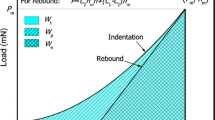Abstract
The causes of the force oscillations observed in instrumented impact tests were investigated. Vibrational modes are excited in cantilever-beam specimens by the initial contact between the striker and the specimen. Although a one-dimensional mass and spring model can predict the oscillations qualitatively, the predicted forces are too large by a factor of two for slender cantilever beams, but approximately correct for lower aspect ratio beams. Computer models can predict the whole of the force deflection curve, but no one-dimensional model can realistically model all the details of the vibrations of a beam specimen. One effective way of reducing the oscillations was to introduce a high hysteresis rubber between the striker and specimen. This was found to produce more meaningful force-deflection or stress-strain curves for polystyrene, without changing the values of the failure stress.
Similar content being viewed by others
References
CEAST booklet, “Advanced Fractoscope System MK 3”, 1986, Torino, Italy.
ICI Australia Operations Ltd., booklet, “ICITACS Instrumented Impact Tester”, 1986.
J. G. WILLIAMS and M. W. BIRCH, “Fracture 1977”, ICF 4 Conference, Waterloo, Canada, Vol. 1, p. 501.
J. G. WILLIAMS and G. C. ADAMS,Int. J. Fracture 33 (1987) 209.
J. S. MOOIJ,Polymer Testing (1981) 69.
P. J. HINE, R. A. DUCKETT and I. M. WARD,J. Mater. Sci. 21 (1986) 2049.
A. J. KINLOCH, G. A. GODOKIAN and M. B. JAMARANI,22 (1987) 4111.
A. GALE and N. J. MILLS,Plastics and Rubber Proc. Appl. 5 (1985) 101.
A. GILCHRIST and N. J. MILLS,J. Occupational Accidents 9 (1987) 199.
K. W. HILLIER,Proc. Phys. Soc. B 64 (1951) 998.
I. M. WARD, “Mechanical Properties of Solid Polymers’ (Wiley, London, 1971) p. 123.
G. C. ADAMS and T. K. WU, in “Fracture of Plastics”, edited by W. Brostow and R. D. Corneliussen (Hanser, Munich, 1986) Ch. 8.
J. G. WILLIAMS, “Fracture Mechanics of Polymers” (Ellis Horwood, Chichester, 1984) p. 238.
,Int. J. Fracture 33 (1987) 47.
N. J. MILLS, “Plastics” (Edward Arnold, London, 1986).
J. F. KALTHOFF,Int. J. Fracture 27 (1985) 277.
T. CHAN, A. M. DONALD and E. J. KRAMER,J. Mater. Sci. 16 (1981) 676.
Author information
Authors and Affiliations
Rights and permissions
About this article
Cite this article
Mills, N.J., Zhang, P.S. The effects of contact conditions on impact tests on plastics. J Mater Sci 24, 2099–2109 (1989). https://doi.org/10.1007/BF02385427
Received:
Accepted:
Issue Date:
DOI: https://doi.org/10.1007/BF02385427




